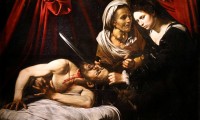 A leaky roof may be responsible for the rediscovery of a long-lost Caravaggio masterpiece. In the attempt to reach the leaking roof of a 17th century house outside Toulouse, in April of 2014 the homeowners broke through a door in the attic that they had never noticed was there. Behind the door was an oil painting depicting the Biblical heroine Judith beheading Assyrian general Holofernes while her begoitered maid Abra holds open a bag in which his head will be placed. It was covered in dust but otherwise in excellent condition. The family called in local auctioneer Marc Labarde to assess the painting. He cleaned the white film of grime off the face of the maid with cotton balls and water and identified it as a 17th century painting from the school of Caravaggio.
A leaky roof may be responsible for the rediscovery of a long-lost Caravaggio masterpiece. In the attempt to reach the leaking roof of a 17th century house outside Toulouse, in April of 2014 the homeowners broke through a door in the attic that they had never noticed was there. Behind the door was an oil painting depicting the Biblical heroine Judith beheading Assyrian general Holofernes while her begoitered maid Abra holds open a bag in which his head will be placed. It was covered in dust but otherwise in excellent condition. The family called in local auctioneer Marc Labarde to assess the painting. He cleaned the white film of grime off the face of the maid with cotton balls and water and identified it as a 17th century painting from the school of Caravaggio.
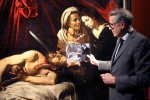 Labarde called in friend and Old Master expert Eric Turquin to examine it further. Turquin spent two years cleaning, conserving and studying the painting. He had it X-rayed and analyzed with infrared reflectography. He found key elements characteristic of Caravaggio’s work: great speed of execution, bold, secure brushstrokes and, because Caravaggio never made preparatory sketches first, changes done midstream to the positioning of Holofernes’ right hand and Judith’s face. Two Caravaggio experts examined the painting and agreed with Turquin that it was the original work lost almost 400 years ago. Another determined it was a copy, albeit a very good one.
Labarde called in friend and Old Master expert Eric Turquin to examine it further. Turquin spent two years cleaning, conserving and studying the painting. He had it X-rayed and analyzed with infrared reflectography. He found key elements characteristic of Caravaggio’s work: great speed of execution, bold, secure brushstrokes and, because Caravaggio never made preparatory sketches first, changes done midstream to the positioning of Holofernes’ right hand and Judith’s face. Two Caravaggio experts examined the painting and agreed with Turquin that it was the original work lost almost 400 years ago. Another determined it was a copy, albeit a very good one.
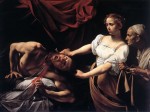 Caravaggio painted an earlier Judith Beheading Holofernes (1598–99) which is now part of the collection of the Galleria Nazionale d’Arte Antica in the Palazzo Barberini in Rome. He made the second in Naples during the first decade of the 17th century. We know of its existence because Frans Pourbus the Younger, a Flemish painter at the Gonzaga court in Mantua, wrote about it in a letter to his boss, Vincenzo Gonzaga, Duke of Mantua. Dated September 15th, 1607, the letter noted that Caravaggio’s Madonna of the Rosary, now in the Kunsthistorisches Museum in Vienna, was for sale in Naples for 400 ducats. Pourbus also mentioned seeing another Caravaggio painting, a Judith and Holofernes, for sale.
Caravaggio painted an earlier Judith Beheading Holofernes (1598–99) which is now part of the collection of the Galleria Nazionale d’Arte Antica in the Palazzo Barberini in Rome. He made the second in Naples during the first decade of the 17th century. We know of its existence because Frans Pourbus the Younger, a Flemish painter at the Gonzaga court in Mantua, wrote about it in a letter to his boss, Vincenzo Gonzaga, Duke of Mantua. Dated September 15th, 1607, the letter noted that Caravaggio’s Madonna of the Rosary, now in the Kunsthistorisches Museum in Vienna, was for sale in Naples for 400 ducats. Pourbus also mentioned seeing another Caravaggio painting, a Judith and Holofernes, for sale.
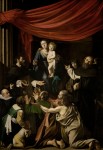 What he didn’t tell Gonzaga was that both works were owned by a good friend of his, Flemish artist Louis Finson. The Duke was unwilling to spend 400 ducats on one Madonna, because a few years later Finson took it to Amsterdam with him. Finson also took Judith Beheading Holofernes to Amsterdam. Both Caravaggio works are listed in his will, but after his death in 1617, the Madonna was acquired by a consortium of artists including Peter Paul Rubens for a church in Antwerp while Judith disappears from the historical record.
What he didn’t tell Gonzaga was that both works were owned by a good friend of his, Flemish artist Louis Finson. The Duke was unwilling to spend 400 ducats on one Madonna, because a few years later Finson took it to Amsterdam with him. Finson also took Judith Beheading Holofernes to Amsterdam. Both Caravaggio works are listed in his will, but after his death in 1617, the Madonna was acquired by a consortium of artists including Peter Paul Rubens for a church in Antwerp while Judith disappears from the historical record.
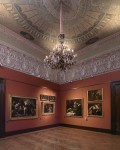 Caravaggio was very famous in his lifetime, and while he never had a literal school or workshop with students like other masters did, he had followers who copied his works and painted pieces of their own that were heavily influenced by Caravaggio’s style. Louis Finson was one of the first Flemish Caravaggisti, as the followers were known, as was Rubens. Finson lived in Naples in the early 17th century when Caravaggio was there too. He owned several of Caravaggio’s original works and copied others. The Finson version of Judith Beheading Holofernes was considered a very faithful copy and since the original was lost, for close to 400 years, Finson’s copy was the only extant image of the work. Finson didn’t take it to Amsterdam and it is now on display in the Palazzo Zevallos Stigliano in Naples.
Caravaggio was very famous in his lifetime, and while he never had a literal school or workshop with students like other masters did, he had followers who copied his works and painted pieces of their own that were heavily influenced by Caravaggio’s style. Louis Finson was one of the first Flemish Caravaggisti, as the followers were known, as was Rubens. Finson lived in Naples in the early 17th century when Caravaggio was there too. He owned several of Caravaggio’s original works and copied others. The Finson version of Judith Beheading Holofernes was considered a very faithful copy and since the original was lost, for close to 400 years, Finson’s copy was the only extant image of the work. Finson didn’t take it to Amsterdam and it is now on display in the Palazzo Zevallos Stigliano in Naples.
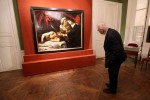 The French government has placed an export ban on the painting which means it cannot leave the country for 30 months. This will give experts plenty of time to study the work in greater detail, and will give French museums the opportunity to tap potential donors for the astronomical sum — something in the $130 million range — required to buy the work should it prove to be an authentic Caravaggio. As a contemporary copy of some quality, Louis Finson’s version will play an important role in the authentication process. One expert believes the newly discovered work is in fact another copy by Finson.
The French government has placed an export ban on the painting which means it cannot leave the country for 30 months. This will give experts plenty of time to study the work in greater detail, and will give French museums the opportunity to tap potential donors for the astronomical sum — something in the $130 million range — required to buy the work should it prove to be an authentic Caravaggio. As a contemporary copy of some quality, Louis Finson’s version will play an important role in the authentication process. One expert believes the newly discovered work is in fact another copy by Finson.